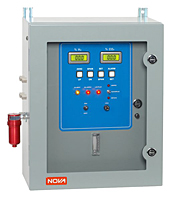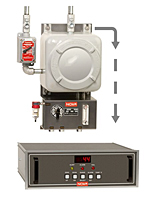|
|
|
|
| 名稱 |
產品展示 |
說明 |
備註 |
 975A連續分析儀 975A連續分析儀 |
 |
975A連續分析儀,空氣成分- O2,CO,CO2,CH4和H2
The Nova 970 Series Syn-Gas Analyzer System has been designed with the flexibility and robustness required in the experimental and developmental environments that characterize syn gas applications.The Nova 970 Series utilizes high-stability infrared detectors for the simultaneous measurement of CO, CO2, and CH4. In addition, the analyzer can also be supplied with a non-consumable, long-life thermal conductivity cell for H2 that compensates for the interference effects of CO, CO2, and CH4. This ensures that H2 will always read correctly regardless of the background gas composition. A non-depleting paramagnetic sensor is used for O2 analysis. All sensors/detectors are temperature-controlled or temperature-compensated for maximum analytical stability. Auto calibration functionality allows easy calibration without user intervention. The included Serial Output Package allows connection of analyzer to personal computers via a choice of USB/RS-232/RS-485. Data recording software is also included. |
|
 42387過程分析儀 42387過程分析儀 |
 |
42387過程分析儀,H2與CO2補償,H2與CO,CO2,CH4補償
The Nova 4230 Process Hydrogen Analyzer has been specifically designed for the accurate measurement of H2 in exothermic or 'DX' gas from a furnace, generator, or other processes with high levels of H2 and CO2. The CO2 acts as an interference to the measurement of Hydrogen when using a thermal conductivity cell (T/C).
To correct the H2 reading for the presence of CO2, the 4230 has a separate infra red CO2 detector. Its purpose is to provide the exact amount of corrective signal for the Hydrogen reading, regardless of the furnace or generator conditions. This is a most desirable feature, especially when trying to obtain very accurate hydrogen readings.
Some manufacturers attempt to compensate the H2 reading for CO2 by advising the customer to obtain a calibration gas that also contains CO2. This approach is only effective at that particular H2/CO2 ratio. As soon as the process gas H2 level deviates from the calibration H2 level, the readings become more inaccurate. Continuous CO2 compensation is the only effective way to deal with this problem. |
|
 42381過程分析儀 42381過程分析儀 |
 |
42381過程分析儀,H2與CO2補償,H2與CO,CO2補償
The Nova 4230 Process Hydrogen Analyzer has been specifically designed for the accurate measurement of H2 in exothermic or 'DX' gas from a furnace, generator, or other processes with high levels of H2 and CO2. The CO2 acts as an interference to the measurement of Hydrogen when using a thermal conductivity cell (T/C).
To correct the H2 reading for the presence of CO2, the 4230 has a separate infra red CO2 detector. Its purpose is to provide the exact amount of corrective signal for the Hydrogen reading, regardless of the furnace or generator conditions. This is a most desirable feature, especially when trying to obtain very accurate hydrogen readings.
Some manufacturers attempt to compensate the H2 reading for CO2 by advising the customer to obtain a calibration gas that also contains CO2. This approach is only effective at that particular H2/CO2 ratio. As soon as the process gas H2 level deviates from the calibration H2 level, the readings become more inaccurate. Continuous CO2 compensation is the only effective way to deal with this problem. |
|
 4381過程分析儀 4381過程分析儀 |
 |
4381過程分析儀,H2與CO2補償,H2與CH4補償
The Nova 4230 Process Hydrogen Analyzer has been specifically designed for the accurate measurement of H2 in exothermic or 'DX' gas from a furnace, generator, or other processes with high levels of H2 and CO2. The CO2 acts as an interference to the measurement of Hydrogen when using a thermal conductivity cell (T/C).
To correct the H2 reading for the presence of CO2, the 4230 has a separate infra red CO2 detector. Its purpose is to provide the exact amount of corrective signal for the Hydrogen reading, regardless of the furnace or generator conditions. This is a most desirable feature, especially when trying to obtain very accurate hydrogen readings.
Some manufacturers attempt to compensate the H2 reading for CO2 by advising the customer to obtain a calibration gas that also contains CO2. This approach is only effective at that particular H2/CO2 ratio. As soon as the process gas H2 level deviates from the calibration H2 level, the readings become more inaccurate. Continuous CO2 compensation is the only effective way to deal with this problem. |
|
 4370過程分析儀 4370過程分析儀 |
 |
4370過程分析儀,H2與CO2補償,H2與CH4補償
The Nova 4230 Process Hydrogen Analyzer has been specifically designed for the accurate measurement of H2 in exothermic or 'DX' gas from a furnace, generator, or other processes with high levels of H2 and CO2. The CO2 acts as an interference to the measurement of Hydrogen when using a thermal conductivity cell (T/C).
To correct the H2 reading for the presence of CO2, the 4230 has a separate infra red CO2 detector. Its purpose is to provide the exact amount of corrective signal for the Hydrogen reading, regardless of the furnace or generator conditions. This is a most desirable feature, especially when trying to obtain very accurate hydrogen readings.
Some manufacturers attempt to compensate the H2 reading for CO2 by advising the customer to obtain a calibration gas that also contains CO2. This approach is only effective at that particular H2/CO2 ratio. As soon as the process gas H2 level deviates from the calibration H2 level, the readings become more inaccurate. Continuous CO2 compensation is the only effective way to deal with this problem. |
|
 4230PMN7過程分析儀 4230PMN7過程分析儀 |
 |
4230PMN7過程分析儀,氫與二氧化碳補償,壁掛式,NEMA7傳感器外殼,面板安裝式控制櫃(兩個獨立的機櫃)
The Nova 4230 Process Hydrogen Analyzer has been specifically designed for the accurate measurement of H2 in exothermic or 'DX' gas from a furnace, generator, or other processes with high levels of H2 and CO2. The CO2 acts as an interference to the measurement of Hydrogen when using a thermal conductivity cell (T/C).
To correct the H2 reading for the presence of CO2, the 4230 has a separate infra red CO2 detector. Its purpose is to provide the exact amount of corrective signal for the Hydrogen reading, regardless of the furnace or generator conditions. This is a most desirable feature, especially when trying to obtain very accurate hydrogen readings.
Some manufacturers attempt to compensate the H2 reading for CO2 by advising the customer to obtain a calibration gas that also contains CO2. This approach is only effective at that particular H2/CO2 ratio. As soon as the process gas H2 level deviates from the calibration H2 level, the readings become more inaccurate. Continuous CO2 compensation is the only effective way to deal with this problem. |
|
|
|